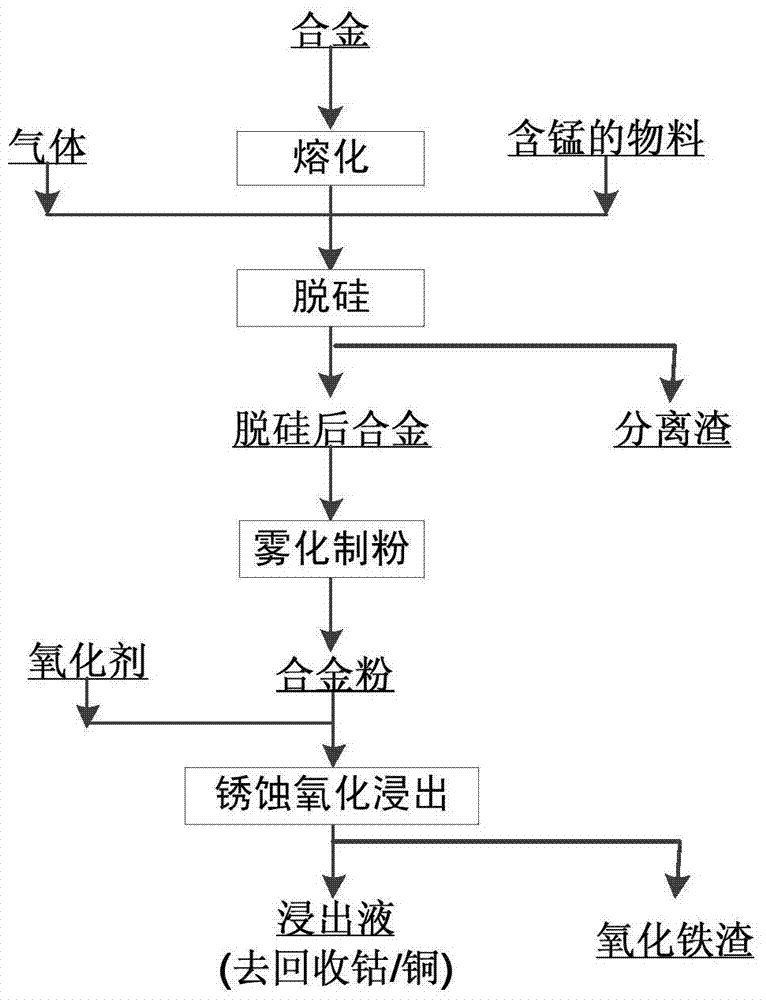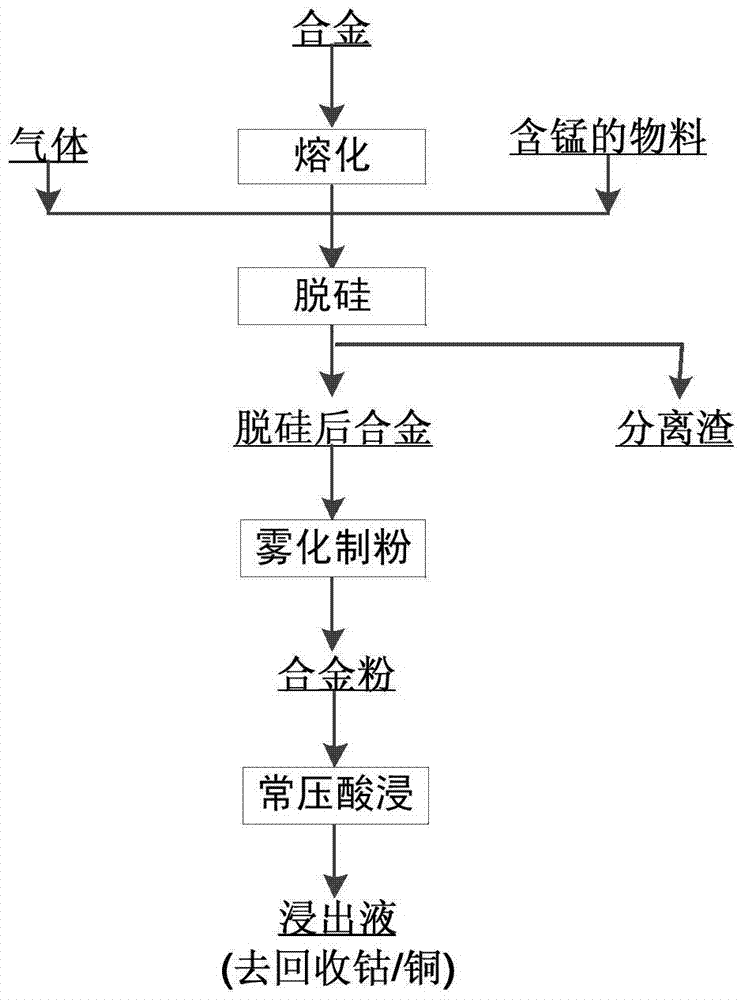A method for leaching valuable metals from cobalt-copper white alloy
A cobalt-copper white alloy and valuable metal technology, which is applied in the field of alloy treatment and leaching of valuable metals from cobalt-copper white alloy, can solve the problems of difficult industrial implementation, high requirements for equipment materials, and limited application effects, and achieve improvement Alloy leaching performance, good leaching performance, and high furnace efficiency
- Summary
- Abstract
- Description
- Claims
- Application Information
AI Technical Summary
Problems solved by technology
Method used
Image
Examples
Embodiment 1
[0038] a kind of like figure 1 Shown the present invention is from the method for leaching valuable metal from cobalt-copper white alloy, comprises the following steps:
[0039] (1) Put 800kg of cobalt-copper white alloy (mass content of main components are Co 38.87%, Fe 32.45%, Cu13.45%, Si 10.15%) into a 1000kg intermediate frequency electric furnace for desiliconization tempering test, set the melting temperature At 1475°C, the cobalt-copper white alloy is melted to form an alloy melt.
[0040] (2) Add 20kg pyrolusite (Mn mass content 39.86%, SiO 2 mass content 13.33%), and at the same time feed nitrogen into the alloy melt (flow rate 10 ~ 25m 3 / h) blowing slagging (MnO-SiO 2 ), by controlling the appropriate oxygen partial pressure, the valuable metals copper, cobalt and iron in the furnace are hardly oxidized, while most of the manganese is oxidized.
[0041] (3) Separating the slagging generated in step (2) from the alloy melt.
[0042] (4) Returning the separated ...
Embodiment 2
[0045] a kind of like figure 1 Shown the present invention is from the method for leaching valuable metal from cobalt-copper white alloy, comprises the following steps:
[0046] (1) Put 800kg of cobalt-copper white alloy (mass content of main components are respectively Co 25.87%, Fe 40.05%, Cu15.45%, Si 15.16%) into a 1000kg intermediate frequency electric furnace for desiliconization tempering test, set the melting temperature At 1550°C, the cobalt-copper white alloy is melted to form an alloy melt.
[0047] (2) Add 5.0kg metal manganese (Mn content 99%) and 12.0kg manganese dioxide powder (MnO 2 content of 95%), and at the same time, a mixed gas of air and oxygen is passed into the surface of the alloy melt (wherein the air flow rate is 12m 3 / h, oxygen flow rate 5m 3 / h,) for blowing slagging (MnO-SiO 2 ), by controlling the appropriate oxygen partial pressure, the valuable metals copper, cobalt and iron in the furnace are hardly oxidized, while most of the manganese i...
Embodiment 3
[0052] a kind of like figure 1 Shown the present invention is from the method for leaching valuable metal from cobalt-copper white alloy, comprises the following steps:
[0053] (1) Put 40kg of cobalt-copper white alloy (mass content of main components are Co 33.83%, Fe 37.10%, Cu16.88%, Si 5%) into 50kg intermediate frequency electric furnace for desiliconization and tempering test, set the melting temperature At 1430°C, the cobalt-copper white alloy is melted to form an alloy melt.
[0054] (2) Add 6.0kg metal manganese (99% Mn content) at one time to the alloy melt, and simultaneously feed air into the alloy melt interior and surface (wherein the air flow rate is 2.5m 3 / h) blowing slagging (MnO-SiO 2 ), by controlling the appropriate oxygen partial pressure, the valuable metals copper, cobalt and iron in the furnace are hardly oxidized, while most of the manganese is oxidized.
[0055] (3) Slag removal once, the slag generated in step (2) is separated from the alloy mel...
PUM
 Login to View More
Login to View More Abstract
Description
Claims
Application Information
 Login to View More
Login to View More - R&D
- Intellectual Property
- Life Sciences
- Materials
- Tech Scout
- Unparalleled Data Quality
- Higher Quality Content
- 60% Fewer Hallucinations
Browse by: Latest US Patents, China's latest patents, Technical Efficacy Thesaurus, Application Domain, Technology Topic, Popular Technical Reports.
© 2025 PatSnap. All rights reserved.Legal|Privacy policy|Modern Slavery Act Transparency Statement|Sitemap|About US| Contact US: help@patsnap.com


